NB: This is a draft article with a number of omissions and content to be added. If you have any in-depth information, or original manufacturer manuals, catalogues or period advertisements that might be relevant, please email Mark here. Peer review and contributors welcome, and will be credited. Similarly, if you have any memorable images shot with these lenses, we’re happy to show them in our gallery with a link to your social media or website.

Noritsu is a japanese company, established in 1956, which was responsible for the invention of the „minilab“ and one of the industry leaders in printing solutions for film for a significant time. Their products were popular in Japan and later on also in the US, where they owned a big share of the minilab market. With the rapid decline of this sector, caused by the rise of digital photography, Noritsu was forced to adapt and enter a number of cooperations with Kodak, Epson and in 2006 even their biggest rival Fujifilm.
While they weren’t able to prevent the market from collapsing, some of their products are held in high regards to this day, particularly their film scanning devices.
Noritsu is still around as a company, however it has changed its portfolio significantly, with their main focus on medical technologies and specialized audio equipment. Its minilab business called ‘Noritsu Precision’ still exists as well, albeit as a separate business entity, providing modernized devices and services.
All that being said, if you never thought of Noritsu as a lens-making company, you’d probably not be alone. I was very surprised to find out there are lenses out there which proudly display their name on them. Let me tell you a little bit about my journey into these vastly untouched territories:
Noritsu Varifocal lenses
There are at least nine versions (but going by price lists, possibly more) of these lenses with variable focal lengths:
| Focal length/f-stop | H-number | Serial number |
|---|---|---|
| Noritsu 26-49/3.4-4.9 | H018043 | 20629* |
| Noritsu 32-60/4.8-6.8 | H018135(L) | 104709* |
| Noritsu 38-60/4-4.8 | H018037 | 107039 |
| Noritsu N 38-60/4-4.8 | H018045 | 514985 – 535690 |
| Noritsu 60-90/4.5-5.6 | H018038 | 242110 – 257534 |
| Noritsu 66-116/7-9.4 | H018134 | 35379* |
| Noritsu 71-111/4.5-5.6 | H018112 | 102330 |
| Noritsu 86-120/4.5-5.6 | H018039 | 305222 – 341995 |
| Noritsu 112-145/8-9.4 | H018044 | 72352 – 77849* |
| Noritsu 135-173/8-9.4 | H0180?? | ? |
Given their variable focal length, my initial assumption was, that they were intended as zoom lenses, but because many of the ones I‘ve seen so far were fixed by some screws and the lack of gears or handles for easily changing the focal length the more likely possibility seems to be, that they were actually used as fixed focal length lenses. This way it wouldn’t have been necessary anymore, to produce a great number of different lenses for every (often quite specific) focal length. That being said 9 variants is not a small number which suggests they were produced to cover a wide range of formats or in part still made for very specific tasks.
The mounting of these lenses resembles the one from the Tomioka/Copal/Tominon-MC lenses quite a bit, so it‘s possible they were used in a similar type of machine. During my initial research a seller described the machine it was used in as a “photo paper processor”, a couple of weeks later I got the information one of these lenses was part of a Noritsu 2211 minilab, but I couldn‘t find any manual or image to confirm that at the time. Another seller described one of the lenses as being part of a “Noritsu model QSS 1501ZU printer”.
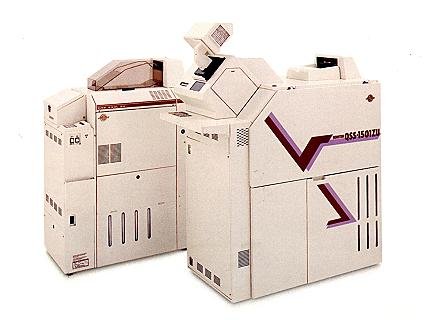
For a certain period I thought the variety of different machines named, might hint towards them being used as film scanner lenses – given these devices are often separate from the printing section of the minilab and could therefore have been used on different models. However over time more hints pointing towards them being lenses used in the printing part of the labs showed up. When I finally got a response from Mümken Sales – the official Noritsu sales- and service partner in Germany – they could verify by some old documents that they were definitely used in the QSS 8, a series of printers with numerous variations which were manufactured between 1983 and 1986.

So assembling all the information I was able to gather so far, it seem like these lenses might have been used in the Noritsu QSS series, at least from the QSS 801 on up to the QSS 2612. One of the lines inbetween, the QSS 1501 is also reported to have used lenses with numbers starting with V, so it’s possible that these lenses either got an overhaul or redesign around that time, or that those V-numbers stand for the whole assembly (including the mounting board and parts to hold the lens in place.

before the full transition to digital printing solutions. (image from Noritsu ad in Foto-Contact Magazin)
To give you a better understanding of how these lenses were mounted originally, I added a shot of one of my lenses including the metal tube they were attached to to the illustration provided by Noritsu.
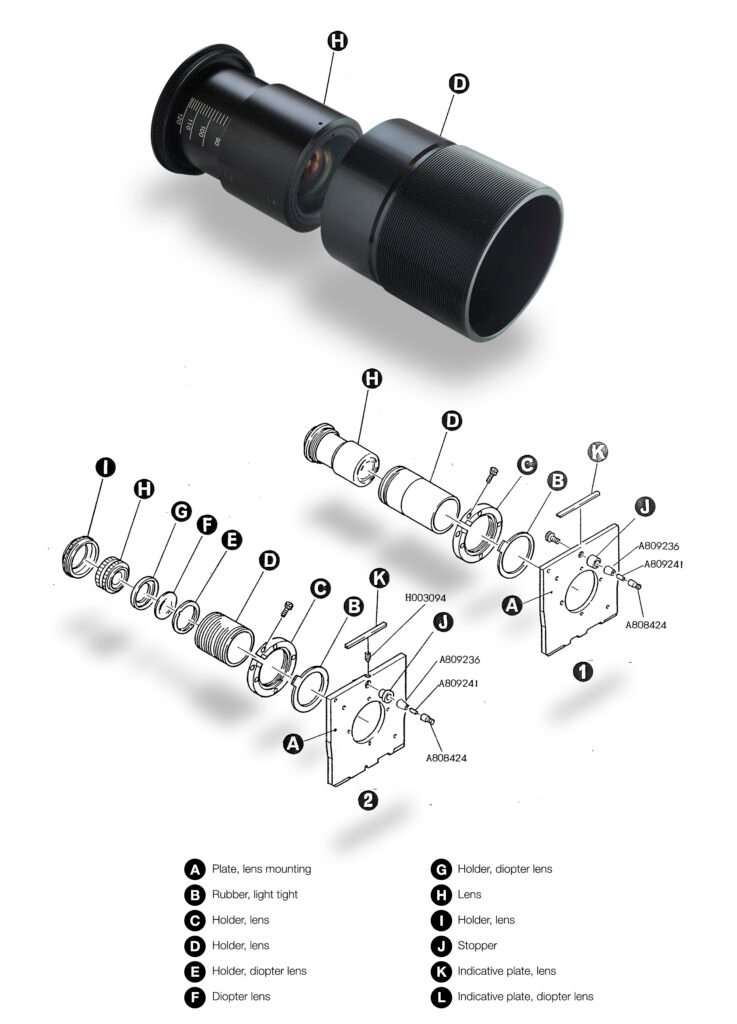
Because of a statement in Robert OToole’s excellent review of the (Tomioka) Tominon-E36 MC 48 mm lens I started to suspect that these lenses might be the “newer zoom optics” he mentions as having replaced these prime printing lenses in the 1980s. Given that usually no company wants a new inferior product to tarnish the reputation of a well established brand, anyone familiar with the aformentioned outstanding EXX(C) Tomioka optics would expect the Noritsu varifocal lenses to perform on a very high level as well. From my experience so far that‘s actually the case and while they don’t fully match the Tomioka prime lenses in terms of sharpness and CA correction, they seem to be absolutely stunning optics, particularly for varifocal ones. Noritsu used some motorized zoom lenses as well, so of course these would also be possible candidates for being a replacement and it seems like both of these types of lenses were actually used simultaneously in different applications.
When I finally had the chance to reach out to Robert OToole, I was able to confirm that the Tomioka made E36(C), E66(C) and E90(C) were actually used in Noritsu machines, an information he got directly from someone working on such a machine for many years. In addition there was also a mention of the Noritsu 32 mm lens, featured a bit further down under “fixed focal length lenses”.
As usual, when you’re intending to use lenses like these as taking lenses, there’s the question of how to adapt them: They have a mounting thread – the shorter ones I tried an 53×0.75 mm and the longer ones a 65×0.75 mm. If you use them in a way you‘d usually see as ‘normal’ however (with the inscription on the front) you have to use a fitting clamp or put the whole lens inside a bellows or big extension tube, which inhibits the ‘zoom-functionality’ and if you mount them in reverse, you have to use the (roughly but not exactly 37 mm) filter thread, which isn‘t impossible to adapt to M42 but also not easy. I found the second mounting solution to provide better image quality at some distance or for close-ups and the first one for high magnification macros.
Apart from adapting and the somewhat tricky mechanism to change f-stops (the aperture range is limited to a few stops, like with many of these lenses) the remaining challenge is finding a lens hood. I‘m sure there is a solution though, it just makes things a bit more interesting or annoying, depending on your attitude and approach.
These lenses are quite sharp and mostly well corrected for CA, but the thing I really like about them is their performance wide open and the incredibly smooth rendering. I‘m pretty sure most people wouldn‘t think of a raw industrial lens like that when they see images made with them. I don’t have a good grasp on usual prices for lenses used in minilabs, but given that many of the similar one-hour-labs used regular higher-end enlarging lenses, which might have been in the range from 150 – 400 $ at the time, the original asking price of 1.320 – 1.650 $ for one of the Noritsu lenses, makes it seem like they were deemed high quality or at least heavily specialized optics.
Who made them?
There is no indication on the manufacturer of these lenses so far unfortunately, but if we assume Noritsu didn’t have any significant lens-making capabilities themselves, I think the most likely would be Tomioka, Fuji, Nikon, Kowa or Pentax. Given that Noritsu seems to have utilized Tomioka-made lenses before and Fuji would probably be considered a direct competitor, I would have put my chips on Tomioka… at least initially. Then again, manufacturers like Kowa or Nikon seemed well equipped to create a process lens with variable focal length as well, because at a certain point in time both have done exactly that… Nikon with the giant, extraordinary complex and fascination “EL-Zoom-Nikkor for NORITSU 99-230 mm f/8” and Kowa with the “Kowa/Computar DL 50-80 mm f/4.5 and 105-150 mm f/4.5-5.6” enlarging lenses.
It was Robert OToole who made me aware of another manufacturer more than capable of developing and producing such an interesting array of lenses: Cosina. They have done a lot of work for many different companies, but so far I have never seen or heard of a single enlarging/processing lens manufactured by them – not even the slightest rumor.
I think there is a case to be made for Tomioka: One reason being the single fact that they are among the most experienced manufacturers in creating high-class enlarging lenses in various focal lengths. Another one being the similar mounting system and finally there seem to be even more tangible cooperations with Noritsu on certain other lenses. One thing that speaks against it, is that they never made another zoom- or varifocal enlarging/industrial lens as far as I’m aware.
In my personal opinion another likely candidate is Nikon, a company who evidently worked with Noritsu as well and even designed one of the most complex enlarging lenses of all time – the El-Zoom Nikkor (featured in its own segment further down) – exclusively for them. Not only did they already have a vast knowledge on and a lot of experience with developing enlarging lenses, as well as various types of zoom- and varifocal lenses in general, they actually had a number of patents granted for different zoom- and vario-lens designs, some even stating a potential use case, very similar to what the Noritsu lenses were made for.
I’ve seen Nikon mentioned on a couple of occasions around the web, but always just as a rumor, like in this blog-entry on a japanese site, where the owner states:
“Noritz purchases lenses from other companies and sells them as components under the NORITSU brand, but I heard that Nikon also supplied lenses.“
Then – out of the blue – another possible candidate appeared in Tamron. As far as I know they only ever made one single confirmed enlarging lens, and yet it bears the name of another company on it. And this company is – you guessed it – Noritsu! It’s very hard to find proof of their involvement in any of the other lenses, so while it certainly seems interesting enough to feature this rare specimen it in its own section of this article, and speculation about Tamron being involved in the manufacturing of other fixed focal length lenses might be warranted, I’m not sure it’s safe to assume any involvement in designing and manufacturing the varifocal lenses at this stage.
I have no idea on the construction of these lenses. Lenses with variable focal length tend to be a bit more complex as far as the number and arrangement of elements go, so that‘s quite possibly the case here as well. One thing that the majority of them have in common, is that they only have one single lens element/one kitted group on the side of the lens where the inscription is.
Or was it Zeiss? (An unsolved online mystery)
While looking for information and images online I found a shot of one of the Noritsu varifocal lenses on the flickr profile of Michael McCoy, a US based photographer, experimenter and producer of his own series of pinhole cameras. In the description of this image he describes his attempt at adapting these lenses for regular shooting. He then mentions the following:
“The quality of the Zeiss and Nikon Optics is superb as the photos show. It is a treat to make some thing work so easily.”
Of couse that immediately made me curious: What did he mean by that? And what did he base this statement on? As mentioned above Nikon is currently the most likely manufacturer of these lenses in my opinion, but still – while some rumors about that can be found online – there doesn’t seem to be any hard proof for it. And Zeiss? I’ve never seen that mentioned anywhere else. I couldn’t find any hint at a collaboration with Noritsu and I’m not aware of any similar type of lens made by Zeiss ever.
It’s possible that he was referring to Tomioka, who produced some of the Contax/Yashica lenses for Zeiss and were rumored to have aquired a lot of Zeiss knowledge and skill in the process, but even that’s a big stretch to be honest.
Of course I tried to reach out to Michael to ask him directly. Unfortunately I had to find out that he had tragically passed away in 2012. So whatever he knew or speculated… it will probably never be uncovered. What’s sure though, is that he was an inventive, creatively thinking human being – a pioneer of sorts – who thought about adapting these excellent lenses 11 years before I even heard of them. So, thank you Michael and R.I.P.!

The image at the bottom shows his workshop, where he was working on his own pinhole camera designs and was shot with one of his own custom builds.
Whatever the truth may be, it seems noteworthy that designing at least 9 of these lenses (probably not even based on anything that already existed before) doesn‘t seem like a small task, and it would be very interesting to know who was up for it.
Noritsu 26-49/3.4-4.9
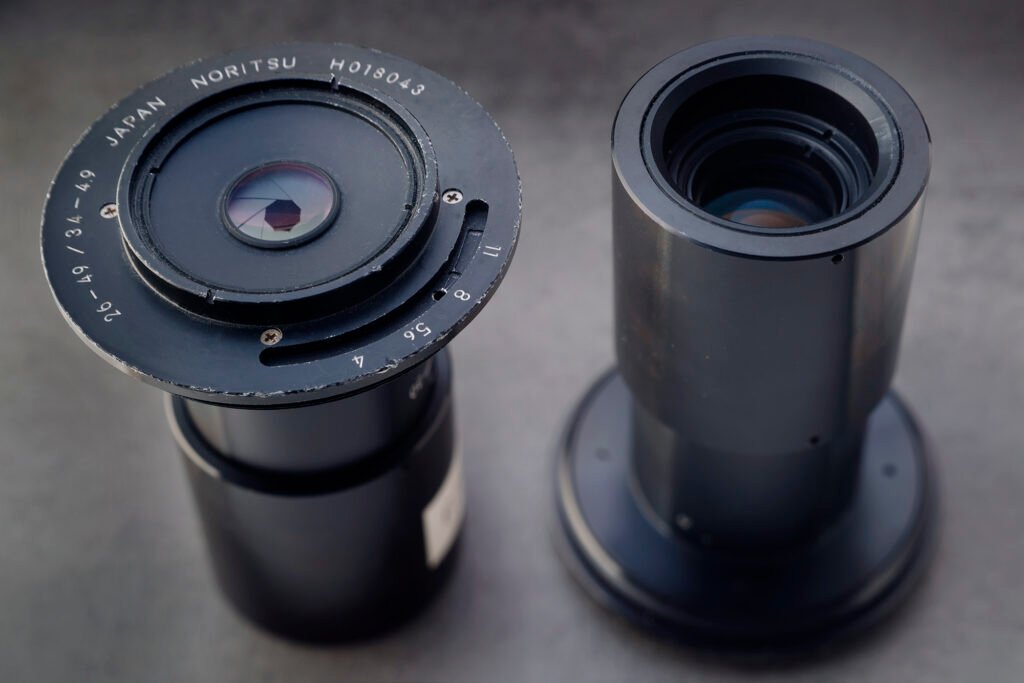
I was really hesitant at first, if this lens was even worth it to adapt, given that I usually only use lenses with image circles that can reasonably cover a full frame sensor… But thinking of its potentially interesting unique place as a relatively wide variable focal length macro lens, I felt motivated to try it. The result was a kind of pure joy in experimenting I hadn’t felt in quite some time, because as someone mainly focused on close-up and macro photography and thus rarely using wide angle lenses (at least non-reversed) it was completely fascinating entering into this new way of seeing things both up-close but also more embedded in their environment at the same time.
This lens is tiny by the way – the smallest of the bunch by a significant margin. Unfortunately it has no filter thread, so the only option is to use its 55 x 0.75 mm thread to adapt it. However this shouldn’t be a big concern to many people, as this lens seems to be significantly more rare than its bigger siblings anyways.
If you find one and are able to adapt it properly, you could get one of the most interesting “wide angle zoom macro” lenses ever… if that’s a thing anyone’s after. While the aperture shape with 8 straight blades isn’t one of my favorites, you can and probably should use this lens wide open most of the time.






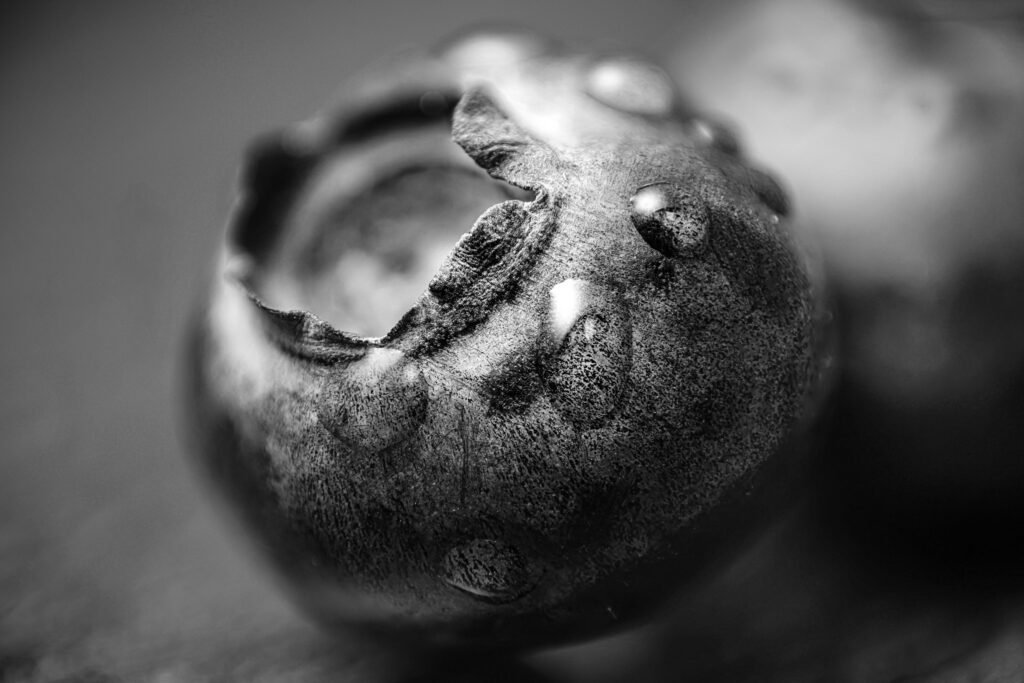
Noritsu 32-60/4.8-6.8

While it isn’t too far off in terms of focal length, the 32-60 mm variant is completely different compared to the 26-49 mm in almost every way imaginable. It has twice the diameter (it’s even bigger than all the other lenses up to the 66-116 mm one), at least twice the weight, different mechanics, mounting thread and a giant protruding front element around 4 times the size.
Unfortunately it doesn’t have a filter thread and it also has got no inscription on it, so all the information about focal length nad aperture values only comes from a small paper sticker on it, which is really strange, given that this could easily come off at any time. All of it suggests that this lens was originally used in a safe place inside of a machine.
In light of the unusual front element I’m somewhat surprised the lens isn’t faster, but maybe it was limited intentionally in order to improve image quality. It has 7 straight aperture blades which, while quite common in taking lenses, is extremely rare in enlarging lenses. However many of its siblings share this characteristic. Wide open the aperture is perfectly round.

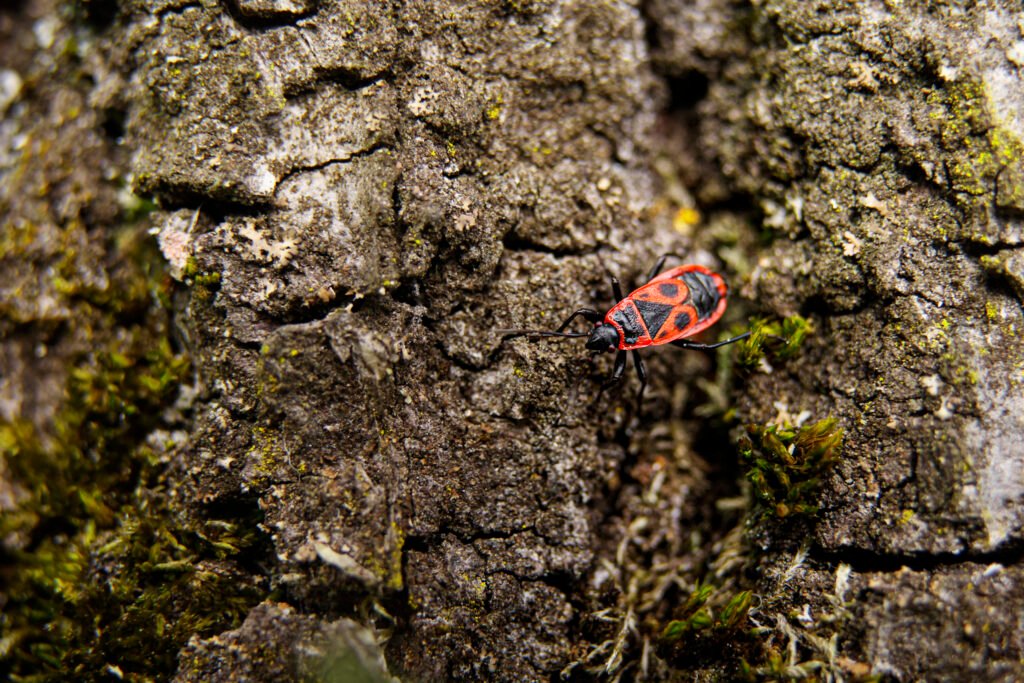


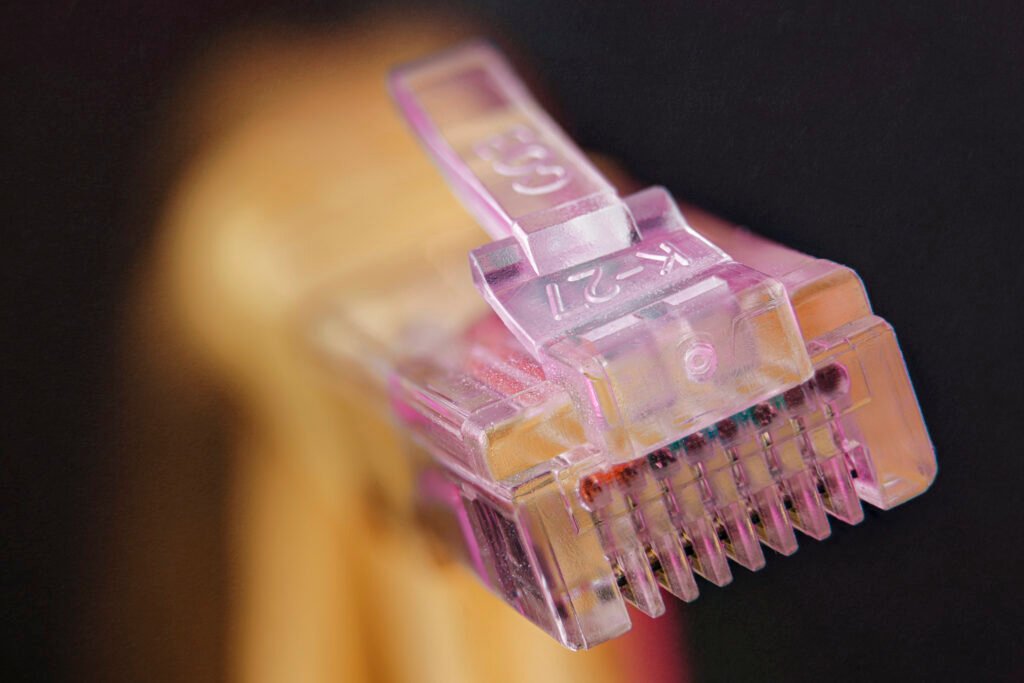
Noritsu 38-60/4-4.8 & Noritsu N 38-60/4-4.8

This was the first lens of the family that I got and it’s quite wonderful, versatile and easy to use. Its front element is slightly recessed, so it’s not as prone to flare as some of the other lenses, it’s relatively easy to adapt, small and lightweight, and the bokeh and transitions are soft and beautiful.
In addition this lens seems readily available and is mostly offered for very reasonable prices. The front element is slightly recessed which makes it less prone to flare compared to some of the other lenses in its family. The 7 aperture blades of this lens open completely, so it shows beautiful, slightly smooth circles wide open.
So far, this is the only one of the lenses I did find two different versions of, one with an N in the inscription, and one without. Going by the higher serial and H-number, I would guess it is just a slightly changed or optimized version.
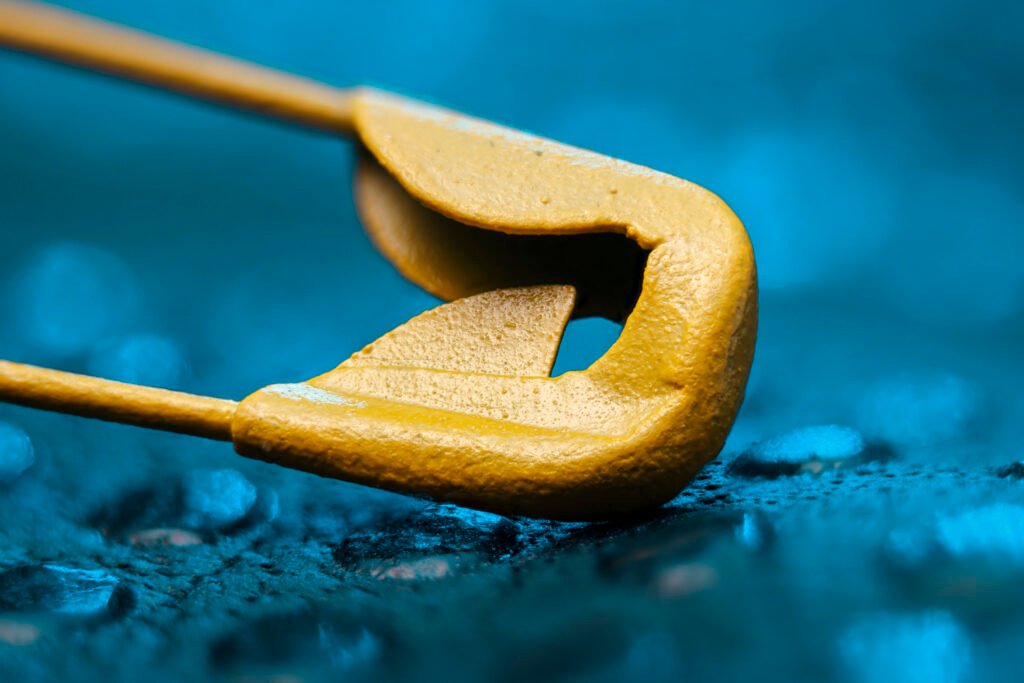



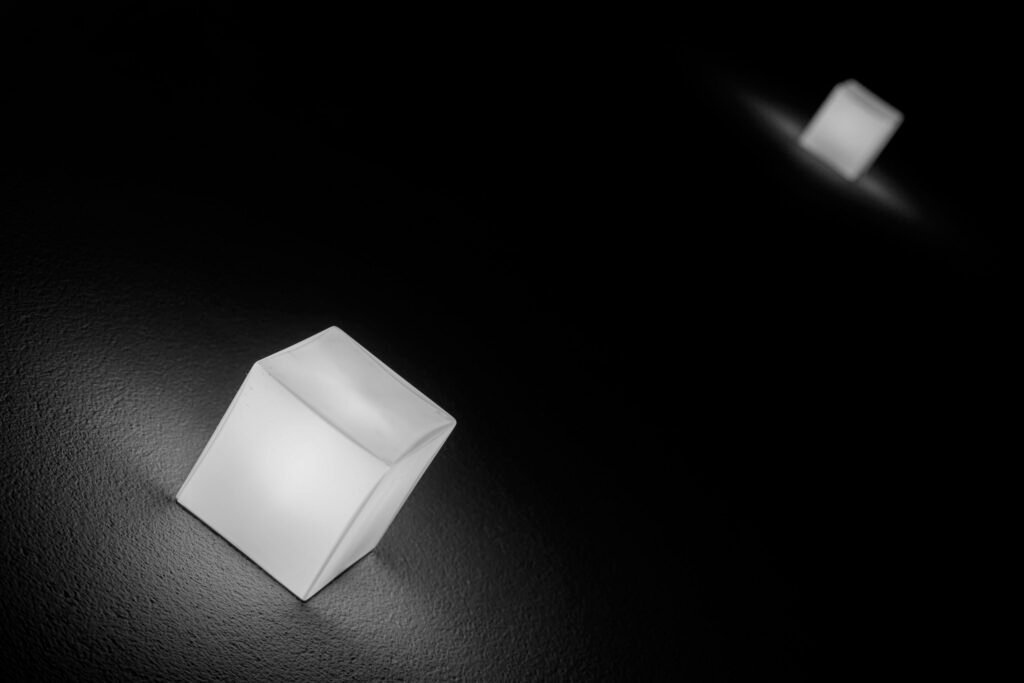


Here’s a comparison between the N and the regular version of the lens:




Noritsu 60-90/4.5-5.6

Very similar in shape and size this lens is a wonderful addition to the 38-60 mm one. It shares most of the traits, however not having a recessed front element, it might flare a bit more easily or loose some more contrast in certain situations. Its focal length range is also quite a useful one and the combination of nice sharpness and (in my eyes) absolutely beautiful out of focus rendering, makes it an easy choice for friends of unusual experimental lenses, being offered for prices comparable to usual shipping cost.
This is also one of the rare lenses, which I tested at infinity. Truth be told, it’s not anything special there and will certainly be inferior to regular taking lenses, however it’s not bad and at 90 mm the image circle might be big enough for a reasonable amount of shift for panoramas, depending on the format it’s used on.
In the close-up range this lens is also a pretty good option for tilting, if you have an adapter or bellows with the option for that. This way you can have the worlds first ever varifocal tilt/shift macro lens… and who wouldn’t want that?
Noritsu 66-116/7-9.4
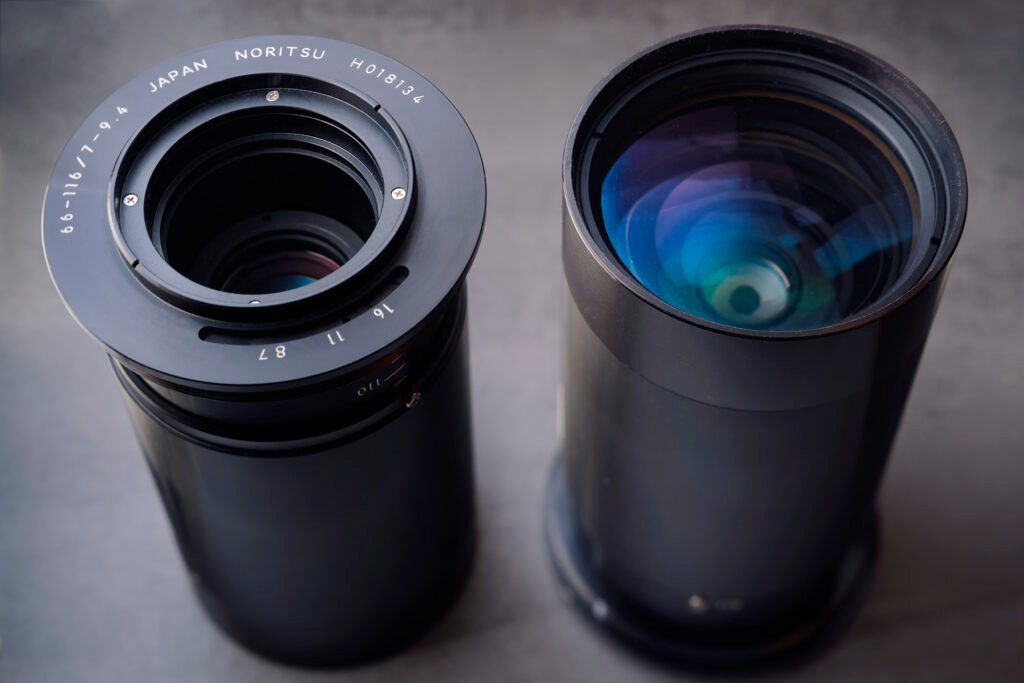
Despite not having the longest focal length, this lens is the biggest and heaviest of the bunch. Similar to the unusual 32-60 mm lens it has a really big front element which doesn’t mean anything in terms of a greater maximum f-stop. On the contrary with f/7-9.4 it is actually quite slow, which might point towards it being limited intentionally, as quite a few other process lenses are as well. Unfortunately it doesn’t have a filter thread, so adaption of this lens is, what I would consider, a real challenge. So far I only managed to get It onto my bellows for a very short amount of time, because the construction I had to use was certainly not built to last. From the quick glimpse I got, I would suspect that someone crafty and patient enough to adapt this lens properly might be rewarded with excellent image quality, but I think the other lenses with similar focal range are significantly more easy to adapt and better suited for photography.
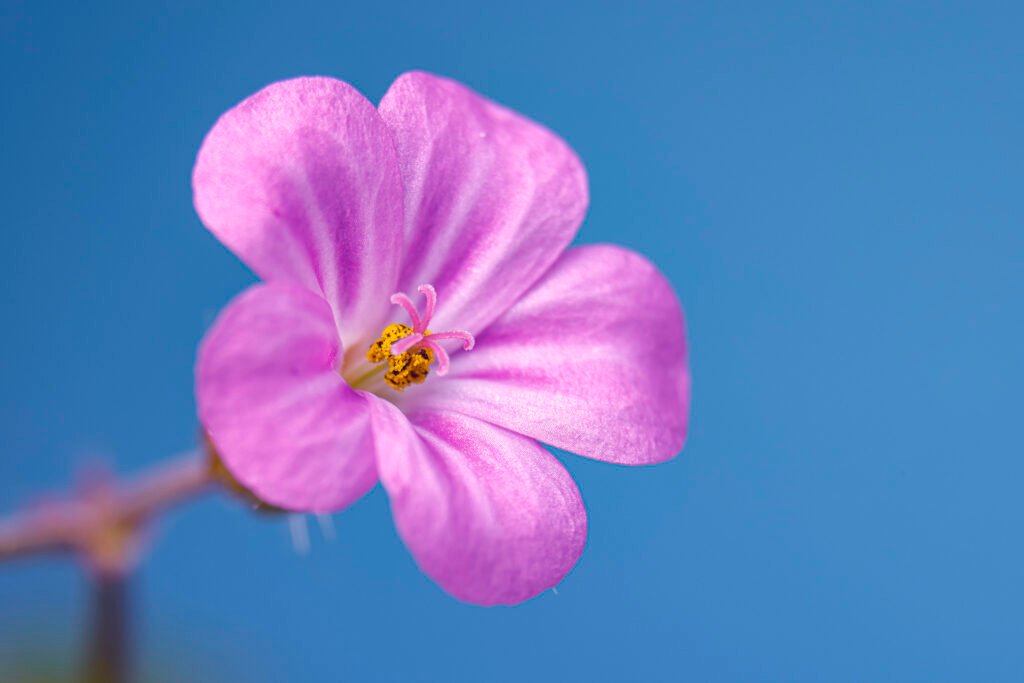

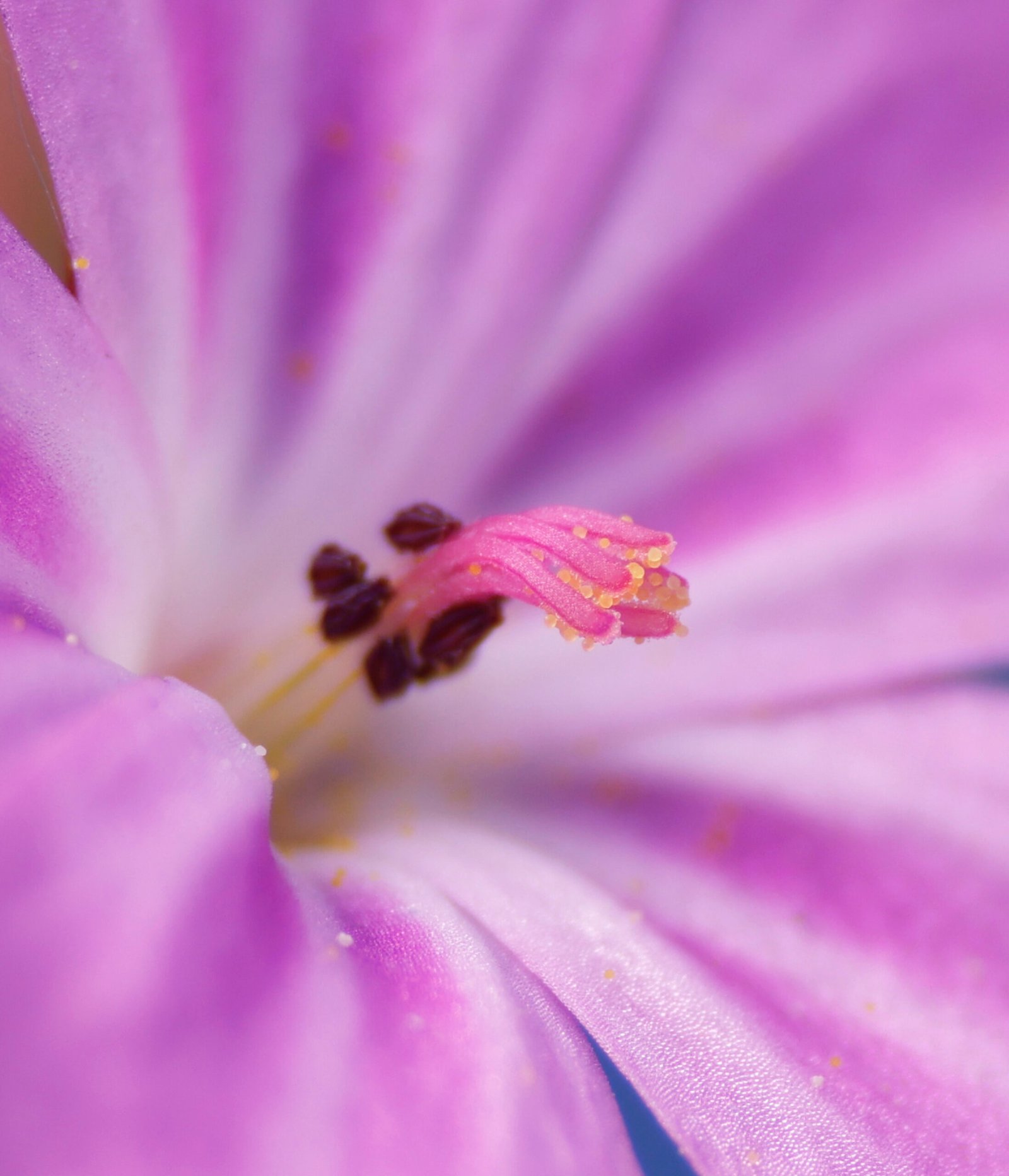
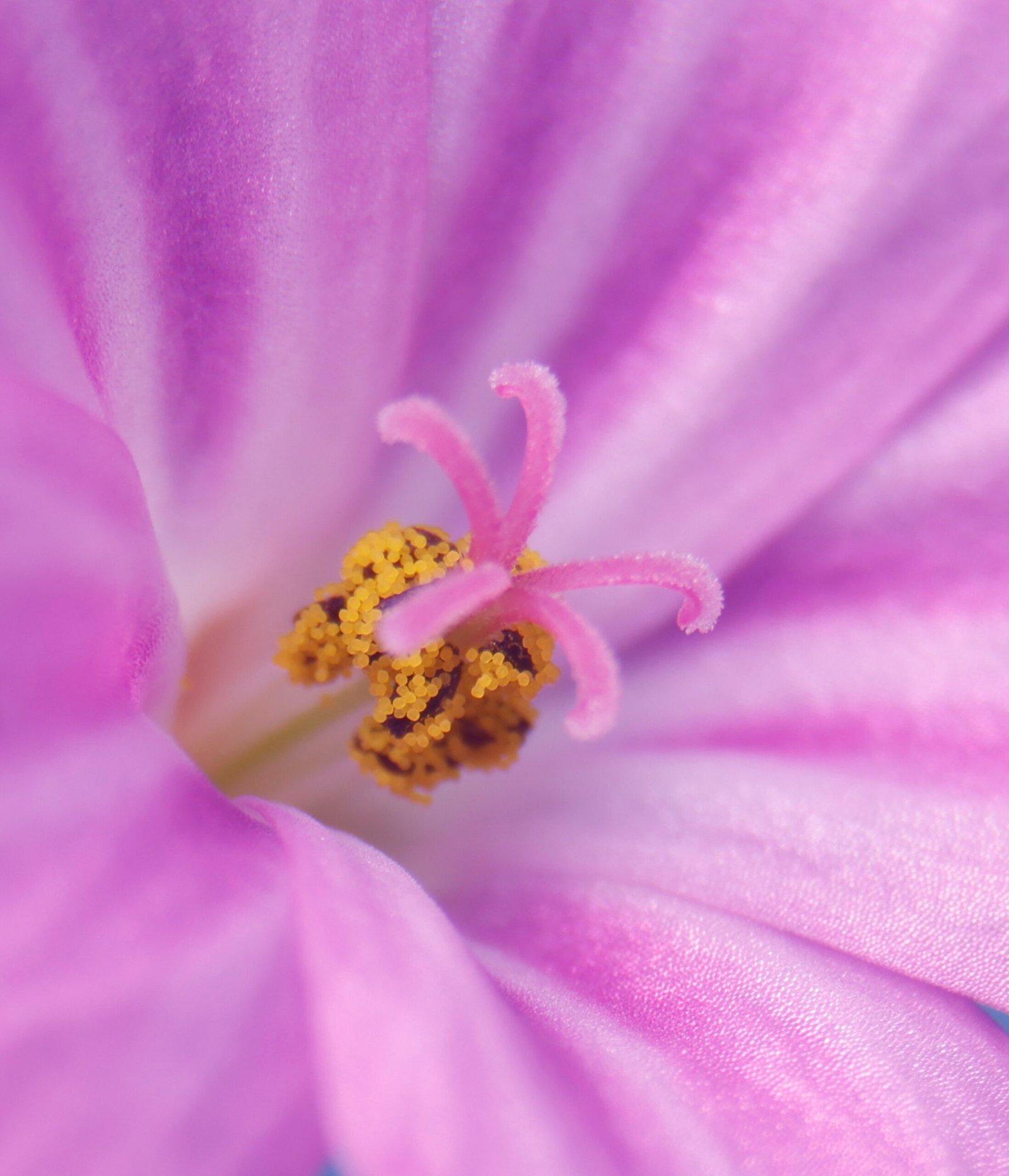
(slightly adusted brightness to match better otherwise SOOC)


Noritsu 71-111/4.5-5.6

I have no idea if it is pure coincidence or if the focal length of 71 mm really has some special importance in terms of format/distance to holder etc. inside Noritsu labs, but I found it quite fascinating that this lens shares that detail with one of my favorite lenses of all time from Tomioka, which – as pointed out before – might have been its precursor.

This lens is quite sharp, well corrected and has a nice focal range. It has a slightly different looking shell and mechanism to change the aperture (somewhat similar to the 32-60 mm version) and my personal impression is that it’s one of the newer lenses. I admit that the physical condition of the lenses I’ve seen might influence that as well and I wasn’t able to match all of these lenses to specific machines, because of the lack of information available. However, knowing, that Noritsu tends to name their products chronologically (H-number), it’s likely the case. The downside, is that this lens is missing the filter thread, which would be a big help in adapting it properly. It’s also a bit tricky to use this lens as an improvised macro zoom-lens (as one does) without accidentally touching the front element of the lens. But let some images do the talking:







Noritsu 86-120/4.5-5.6
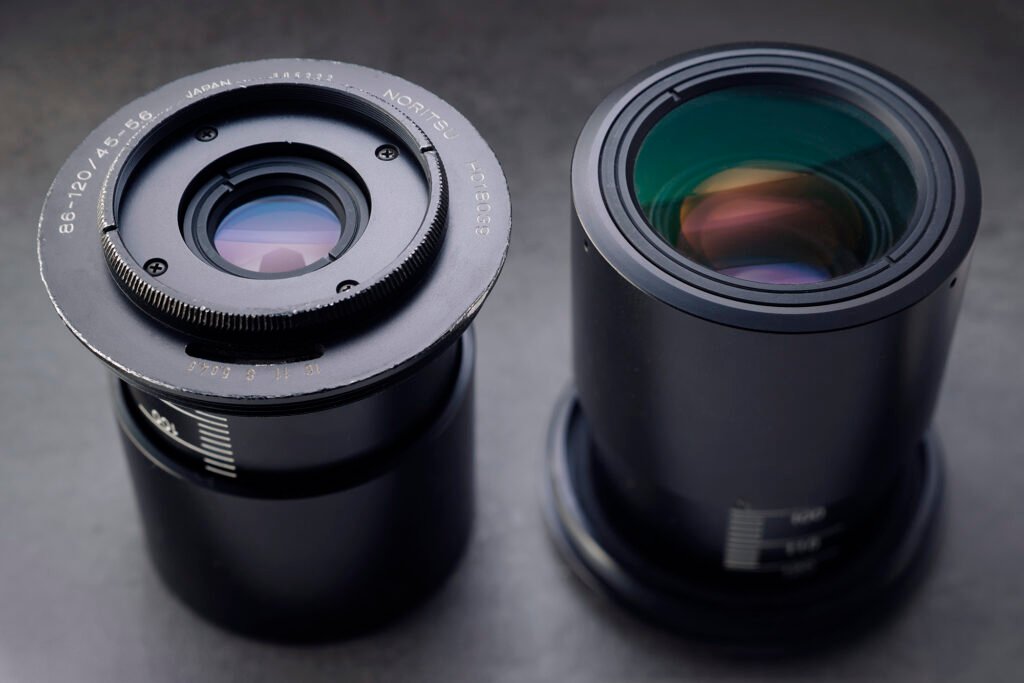
This is the third one in what I might call “the initial Noritsu trio” (38-60, 60-90, 86-120 mm) and their ascending H-numbers seem to give some credence to the title. It’s very similar in structure and usability, but of course slighly heavier and thicker. Compared to the newer lenses in the family with similar focal length, it shows a significant amount of chromatic abberations in situations with challenging lighting, but apart from that it’s a very solid lens as well.

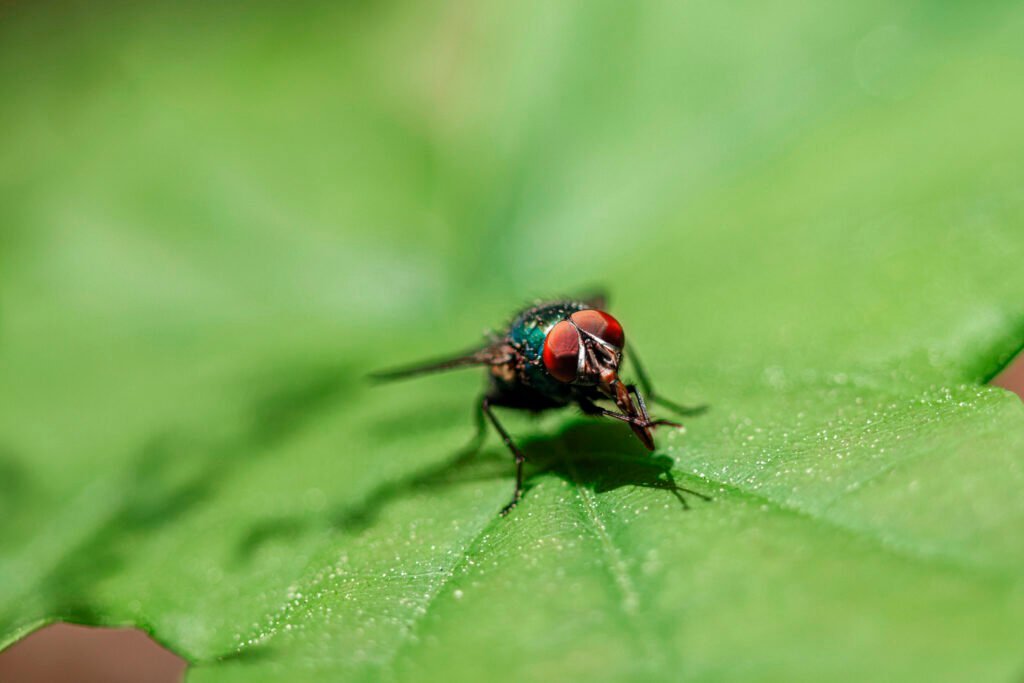




and the clearly better corrected 71-111 mm on the right.

Noritsu 112-145/8-9.4

This is another different looking lens with its rear lens group extending far beyond the aperture ring. At f/8-9.4 it’s far from a fast lens and it’s not easy to adapt. Interestingly this is one of two lenses with a focal length that extends significantly beyond the range, the longest of their assumed precursors, the Tomioka/Copal E90(C) lenses covered (which ended at 125 mm), so either they replaced a different group of lenses, or provided some additional range for a new set of capabilities modernized minilabs needed.


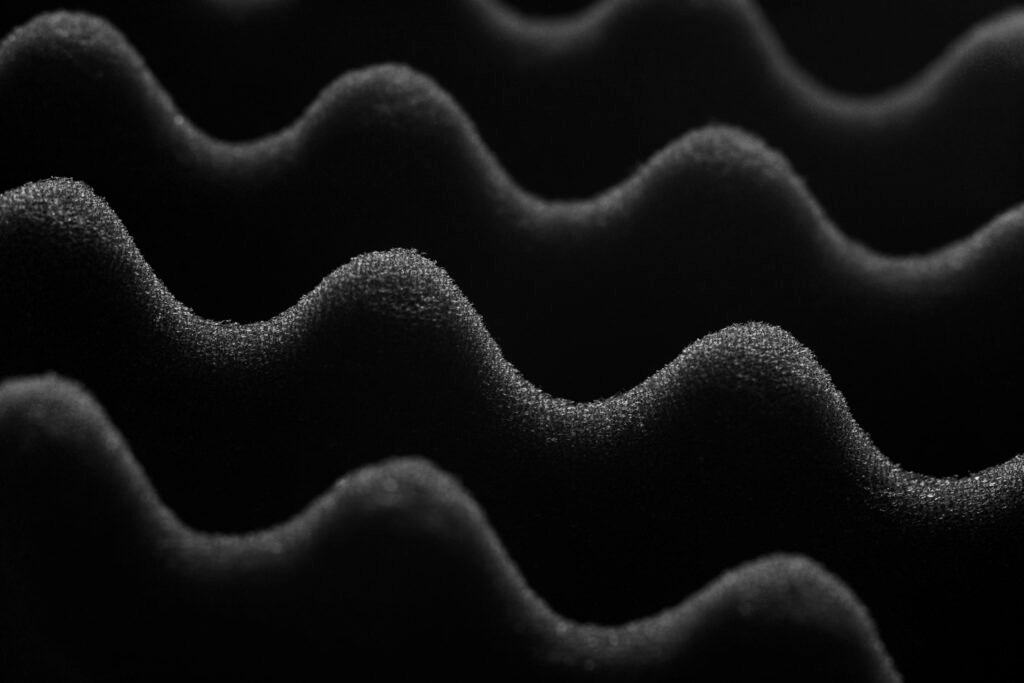
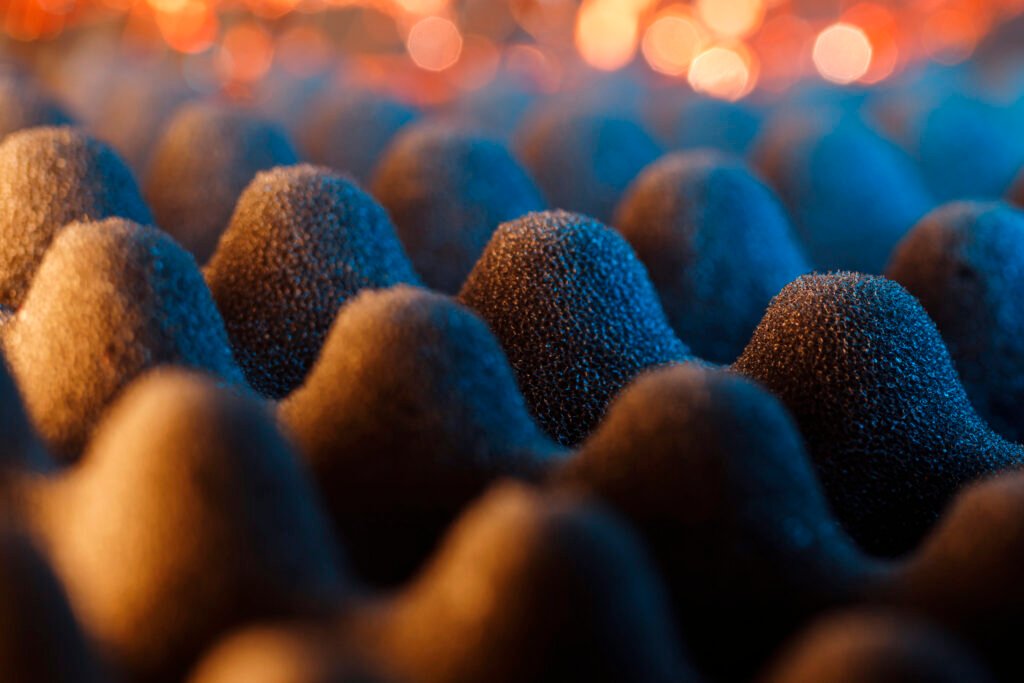
Noritsu 135-173/8-9.4

I haven’t tried this lens, but by looking at images online, I’d assume that it looks and handles very similarly to the 112-145 mm variant, which means it might pose a challenge to adapt (at least without a bellows)
You can find a short description (in Japanese) as well as some images on photographic experimenter Zagane’s muuseo page.
A connection to Agfa?
Agfa was a direct competitor of Noritsu in the minilab space, whose industrial lenses we try to cover here:
Agfa-Gevaert: Industrial lenses
While Agfa often used their own uniquely designed lenses in their minilabs, they seem to have used a couple of vari focal lenses inside of their MSC2 line, that looks suspiciously similar to the Noritsu lenses. It would be interesting to compare them and even more fascinating knowing if a shared third party supplier made both of these lenses and who that was. If you know anything about thate, please reach out to us and help solving that mystery.
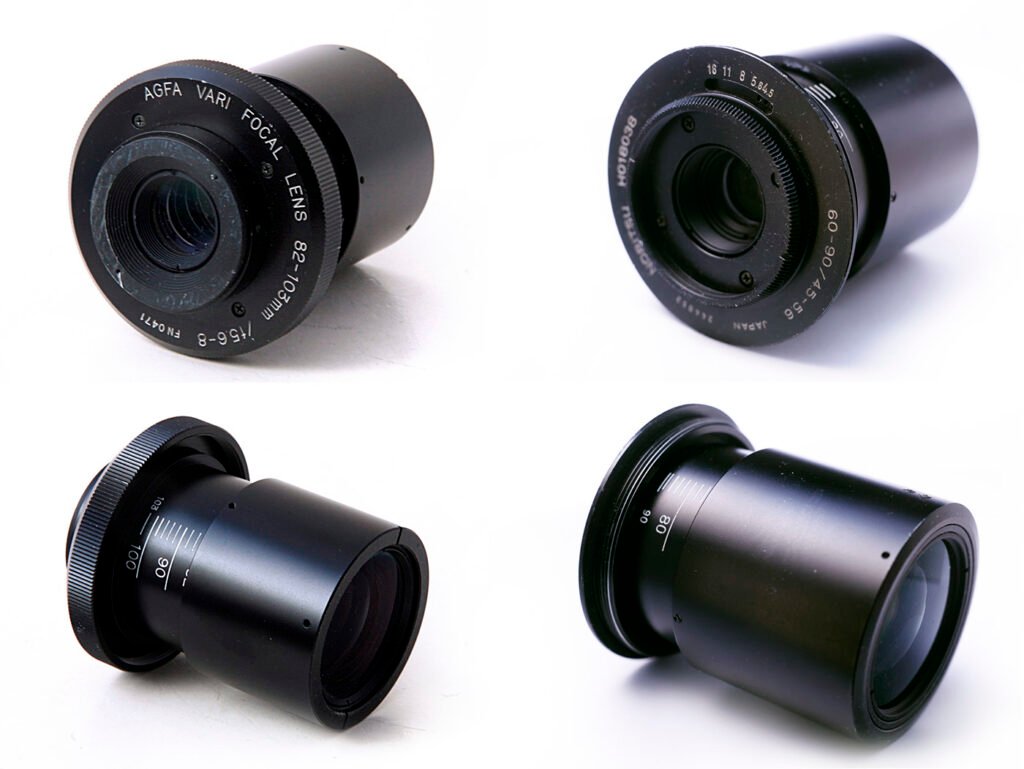
Fixed focal length lenses
| Focal length/f-stop | H/A-number | Serial number |
|---|---|---|
| Noritsu 32/4 | A805451 A805708* A805708(-2) | |
| Noritsu 45/4 | A805708* | |
| Noritsu Tamron 48.5/2.8 | No.830207 | |
| Noritsu 50.7/9.5 | H018085 | 9612 |
| Noritsu 124/21 (2 UP lens) | Z902703 | |
| ??? | H800123 | |
| ??? | H805369 | |
| ??? | H805572 | |
| ??? | A900788 |
* There’s no explanation why these two different lenses share the same A-number, but it’s quite possible that the Noritsu 45/4 was introduced at a later date and superceded the 32/4 for certain tasks. This would also explain why the Noritsu 32/4 might have gotten a -2 at the end of its number.
Noritsu 32/4

The Noritsu 32/4 was used alongside the Tomioka E36(C) lenses in a Noritsu minilab according to a contact of Robert OToole who deems it an excellent macro lens at certain magnifications, particularly when used in a stacked lens setup. It is featured in a couple of comparison tests on his site closeuphotography.com:
4x lens test
35 mm lenses compared at 3.4x
There’s not much to add to Robert’s observations – it’s a truly excellent macro lens, very well corrected and covers full frame within that range. I also tried using it for some close-up shots and as you might expect it starts to show some vignetting and a significant drop in quality towards the edges. Because it has a fixed aperture it’s also quite limited as a taking lens, however if you want a truly outstanding wide-angle macro lens with shallow depth of field (f/4 is for macro work, after all), beautiful smooth rendering, excellent correction and handling of color and great resolution, you can’t go wrong with this tiny piece of glass.


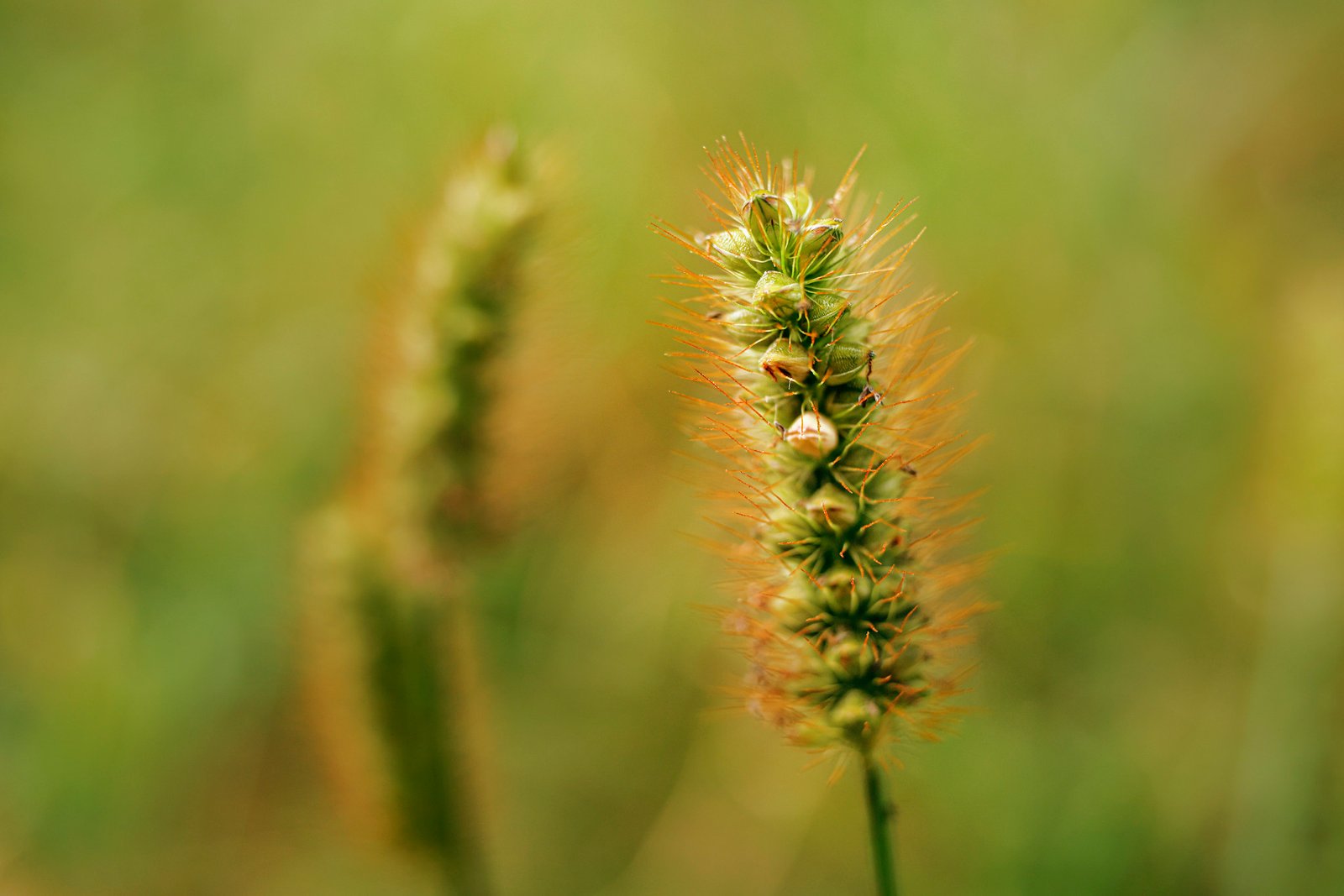




Lens design and maker
Like most Noritsu lenses this 32 mm lens doesn’t have any maker on it. While I initially suspected that Tamron might be a possible candidate (because of some optical similarities to the 48.5 mm variant, mentioned further down) I started to change my opinion when I first got my hands on it. The main reason lies in the lens design. I didn’t take it apart completely and certainly admit some room for error in my observations, but it seems to me like this lens might be a Tessar or Reverse-Tessar design (depending on the direction it was mounted in, which isn’t documented anywhere as far as I know. If that’s the case another lens with similar focal length and aperture comes to mind immediately: the excellent Tominon 35/4.5 made by Tomioka. If you’re interested in macro-photography and have never heard of this little gem, I’ll once again recommend that you check out Robert OTooles review and numerous comparison tests including it.
While it doesn’t match the Noritsu 32 mm in every aspect the similarities are there: they are a equivalent size, have the same thread size, extremely similar lens design (Tessar), very close rendering style, identical color-rendition as well as the overall similarly excellent sharpness and resolution at close distance.
So, unless some more information on the extent of Tamron’s involvement in the manufacturing of Noritsu lenses arises, it’s also plausible to assume that Tomioka might be responsible for this one.
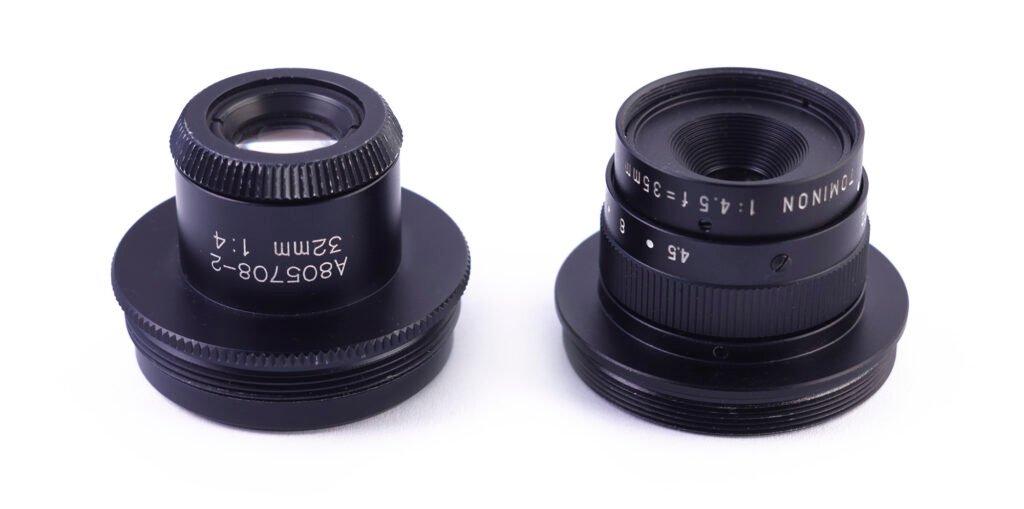


(both cropped slightly, otherwise SOOC)
Noritsu 45/4

Truth be told, I was very hesitant to even get this lens at all. Because judging by some online shots it just looked a lot like the cheap series of triplet 50/3.5 enlarging lenses, which was marketed under a number of different labels. However the identical A-number to the proven Noritsu 32/4 lens and more subtle but meaningful differences like the limited aperture range (often a sign of specialized, high quality lenses), made me realize, that this lens could be a significant step up in quality.

And indeed… what great fun there was to be had with this lens, especially when you factor in the added possibilities of the unusual star-shaped aperture. This lens likely has a 4/3 Tessar type construction and its combination of a wonderful soft out-of-focus look with a sufficiently sharp focus area plus the added novelty of the various possible geometric star-shaped bokeh highlights, provide a completely unique and interesting experience.
Unfortunately it seems like this lens wasn’t produced in high numbers – at least I haven’t seen any other samples yet. But if you happen to stumble across one, maybe consider picking it up, instead of lumping it in with the abundant cheap triplets, like I did initially.
I’m not sure who could have made this lens. If the 32/4 lens was indeed made by Tomioka the similar (Tessar) design of this one might point towards that as well. If the (different, but also star-shaped) aperture is any indication, this might be another Tamron-made lens. The lack of a serial number certainly doesn’t help.
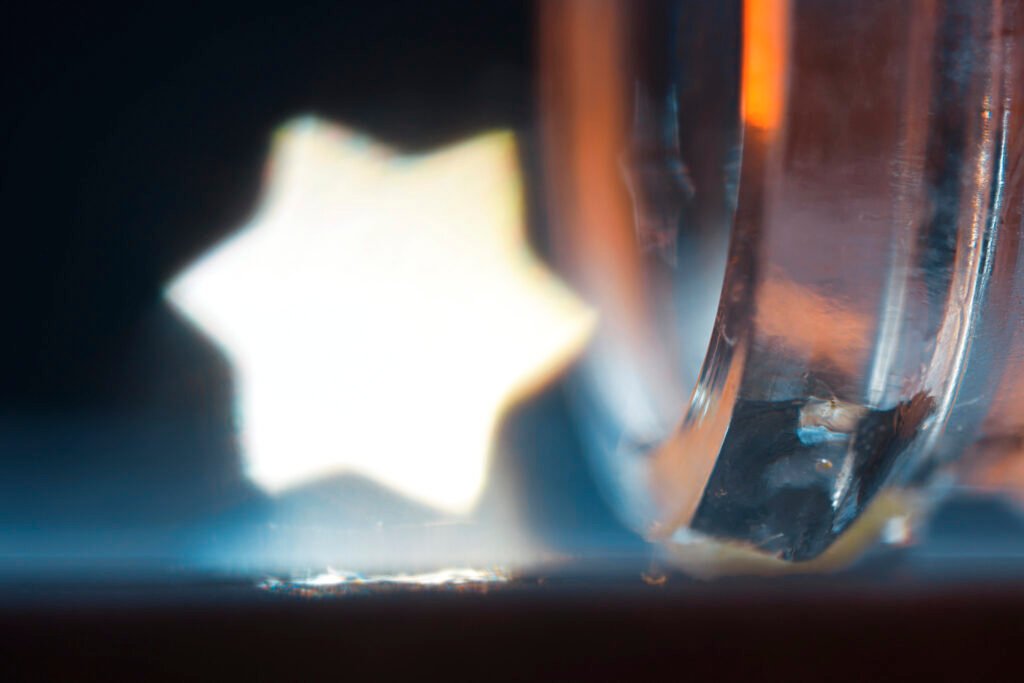

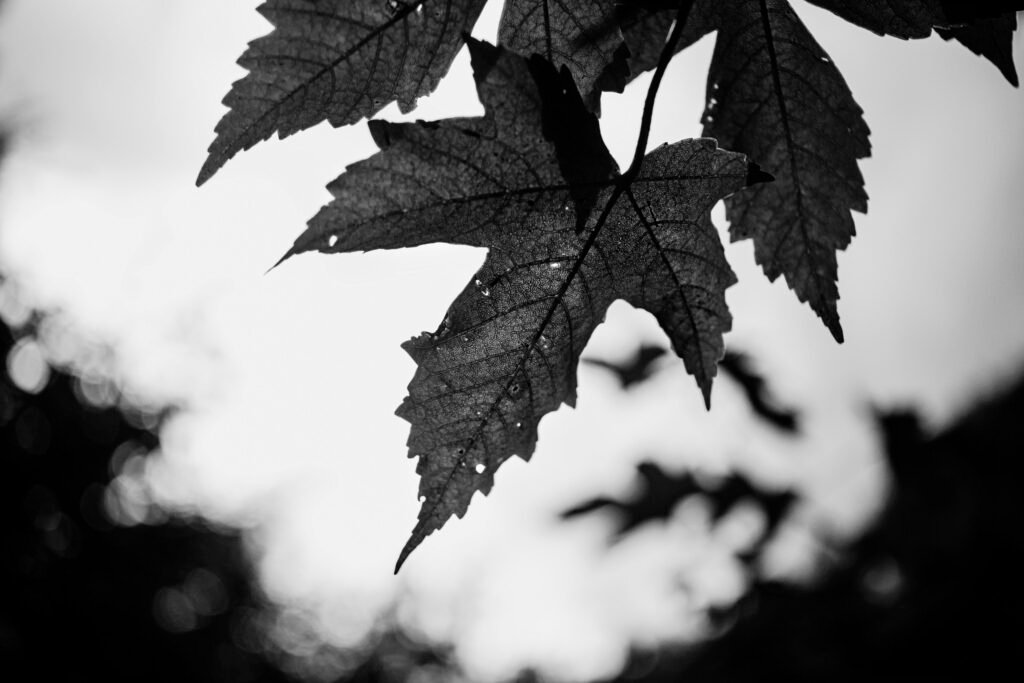
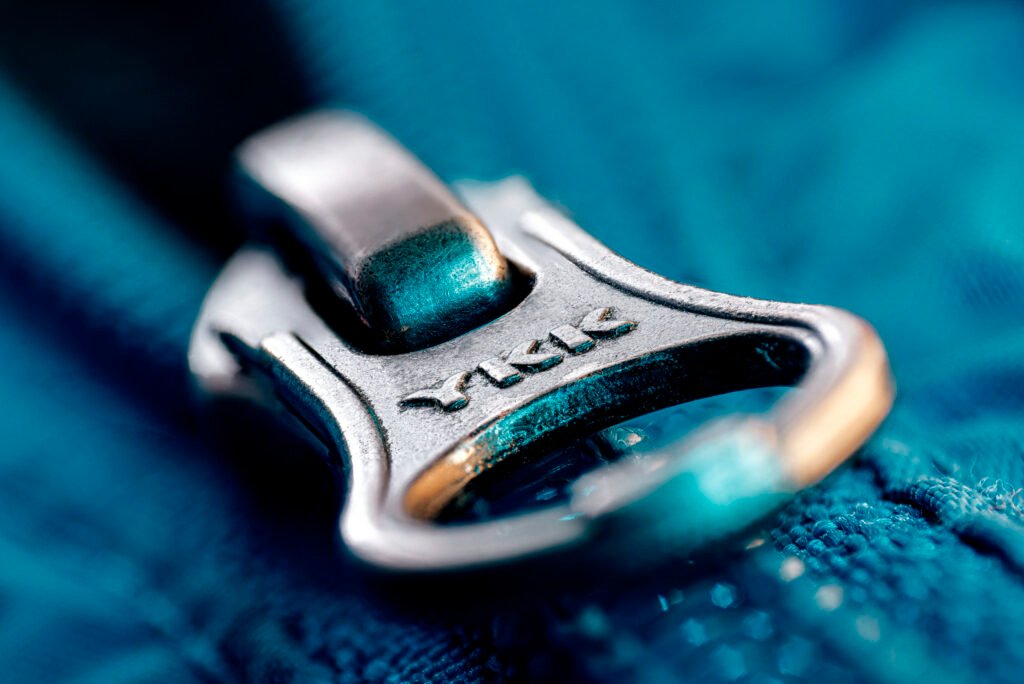



Noritsu Tamron 48.5/2.8
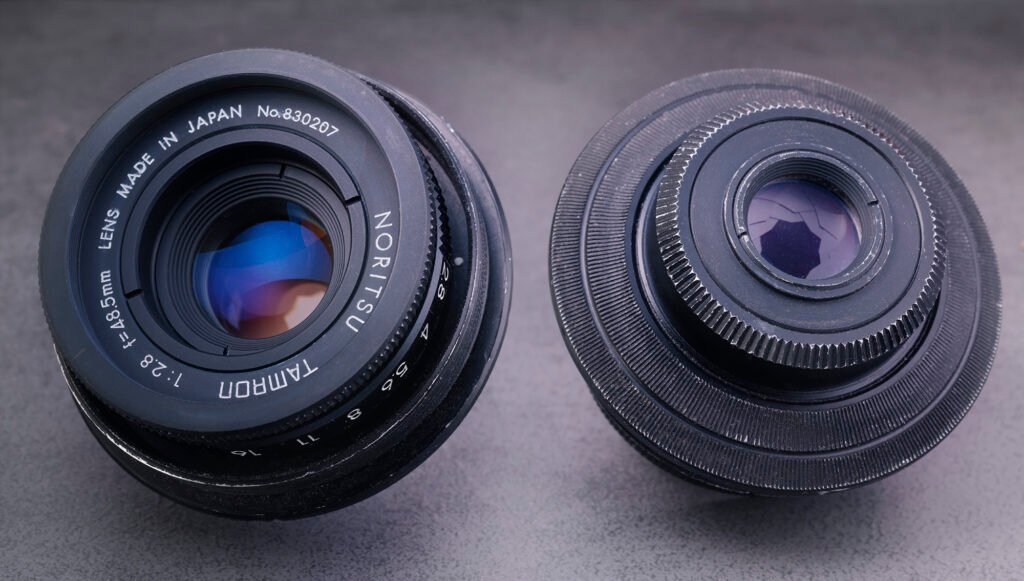
The mere existence of this lens is a riddle in and of itself. What the heck is it? What was it used for? Why is Tamron involved all of sudden, and why does it have a focal length of 48.5 mm? I would like to give some real answers to that, but unfortunately I wasn’t able to find out anything substantial about this lens yet.
This lens seems to be a 5 elements in 3 groups Heliar design from my observations and while my particular sample is in a pretty bad state as far as the glass goes, it still is a very good lens overall. At first it really appeared to me that this lens didn’t have any resemblance or features which could hint towards its use or a group of lenses it might belong to. But looking at images of the Noritsu 32/4 lens, I started to see some similarities in the edges and the way the lenses were mounted. Given that both are lenses made for Noritsu and that the manufacturer of the 32 mm lens is still unknown, there is a real possibility of a connection.
In all of my research I could only find one single mention of this lens (+ a couple of images made with it) on the web and there was no trace of the author… Thankfully I found out that fellow macro-enthusiast Robert OToole also owns one of these. So I was able to find evidence for the serial number indeed being a serial number (not some variant of the Noritsu-typical H-numbers) and confirm my suspicion that my lens might have an adapter stuck to it. This additional ring seems to be the one marked with the letter ‘I’ in the official illustration further up in the article.

This is a wonderful lens. If it wasn’t in such a bad state I would suspect it being among the best enlarging lenses in proximity of the common 50/2.8 specs, rivaling many 6 element lenses. And in addition to being quite sharp, even wide open (at least in the center of the frame), it shows the wonderfully smooth out of focus rendering and transitions many Heliar-type lenses are renowned and liked for. Tamron certainly put some effort into the only enlarging lens to ever bear its name.
While it shows some visible traces of CAs in more challenging lighting conditions, I’ve no way of confirming whether that’s more due to the well-worn condition of my sample or an intrinsic weakness. If you happen to find a sample of this lens (it seems quite uncommon) in good condition and are able to test it, please let us know.





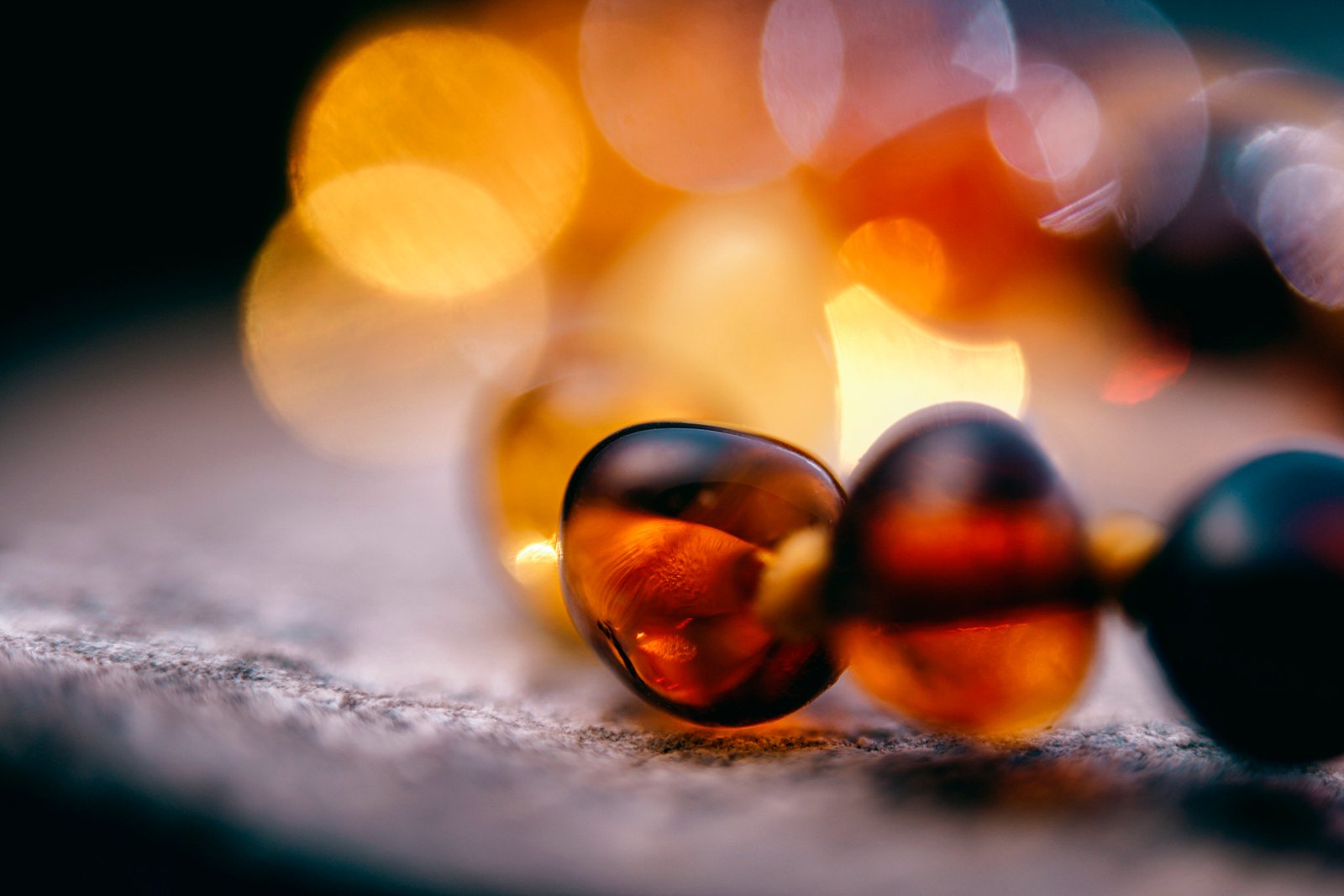



The Tominon-MC 48/4 is among the best of the best enlarging lenses in its focal length; so it’s no surprise to see that the Tamron Noritsu lens can’t keep up. But while it shows a suprising amount of vignetting (for an f/2.8 lens, at f/4) and distinctively weak corner performance, it almost matches the elite 6-element lens in the center, which hints towards the preferable use of this lens in practice.
Noritsu 50.7/9.5
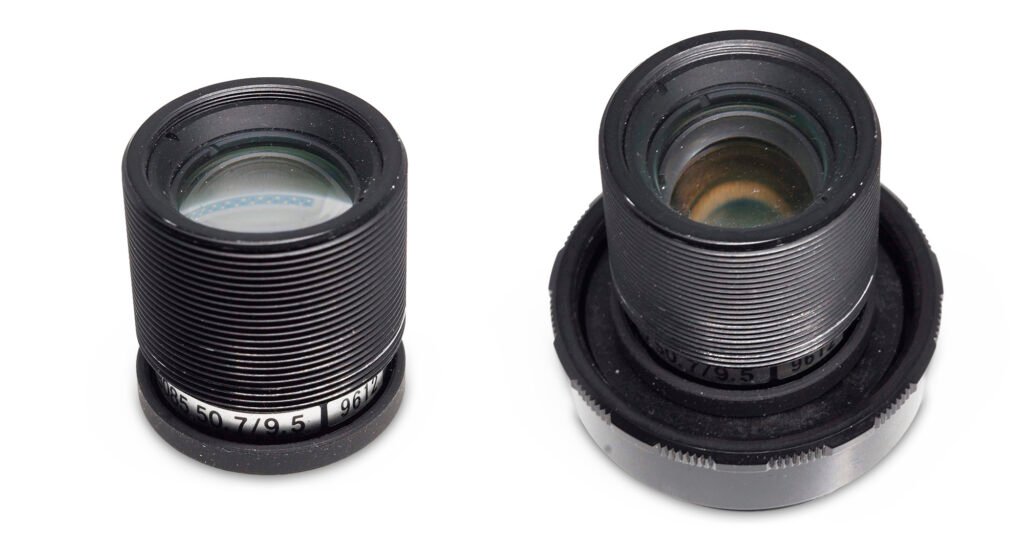
Because of the fact that I don’t own this lens myself I reached out to Martin, a curious and kind soul from Germany, who helped me out enormously by providing both, images of the lens itself and his great looking repro-stand, as well as some sample images. Going by his experiences and observations, this lens – with its quite unusual focal length of 50.7 mm and a fixed aperture of f/9.5 – is really capable for macro photography, sharp and high resolution, but also somewhat limited by its fixed aperture and overall complicated to use.
You can find some sample images below or on Martins flickr profile.
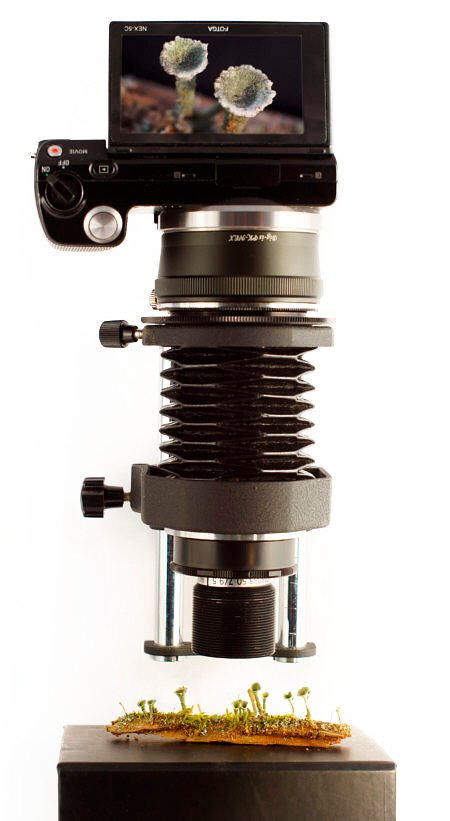




Noritsu 124/21 (2 UP lens)
Because I’ve tried some so-called 2UP / 4UP lenses by Agfa before and not gotten satisfying results, I’ve not used any of the Noritsu ones. However Robert OToole has tried one, so I encourage you to take a look at his findings here.
Suffice to say, they can’t be recommended for adaption.
Zoom lenses
Zoom NC 2.18x – 7.04x (H018149)
We have to assume that this lens can’t really be recommended for adaption – see below!
Zoom NC 3x – 15.6x (H018070)
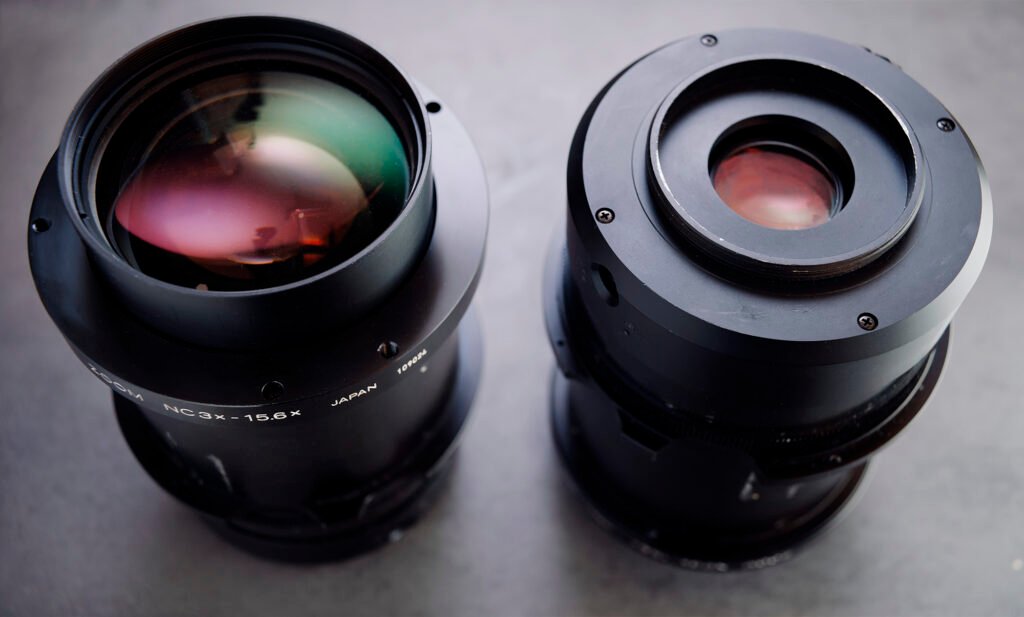
I freely admit, that I was in way over my head when trying to adapt this monster of a lens. I’m far from a crafty person in general, and when it comes to a lens with two motors and cables attached to it, I’d usually stay as far away from it as possible. However this time curiosity got the better of me, and with the help of Robert OToole (who made me aware of how to change the aperture after having the motor in charge of that removed…) I finally managed to strip the lens down to its essentials without doing any damage to the glass at least.
At the point where I had my haphazard adaption ready and started shooting, Robert had already tested it and formed some thoughts. I highly recommend reading his excellent article on his test results and overall experience with this lens.
I immediately started to use this lens in a way its creators surely wouldn’t have guessed this lens would ever be used: outside, handheld. It’s probably no surprise to hear that running after hoverflies and grasshoppers didn’t net any good results so I mostly stuck to inanimate objects and tried to find perspectives where I could let part of the setup rest on the ground or something sturdy. This way shooting was quite fun, even though the images clearly showed significant flaws in the form of low contrast, glowing edges and very noticable chromatic aberrations.
So in this case I fully agree with Robert, and recommend not to buy this lens, because there are way better and easier alternatives out there and even though it might not be totally impossible to get some usable results out of this lens, if you can get to know more about and perhaps motify it. It’s just not worth the effort.



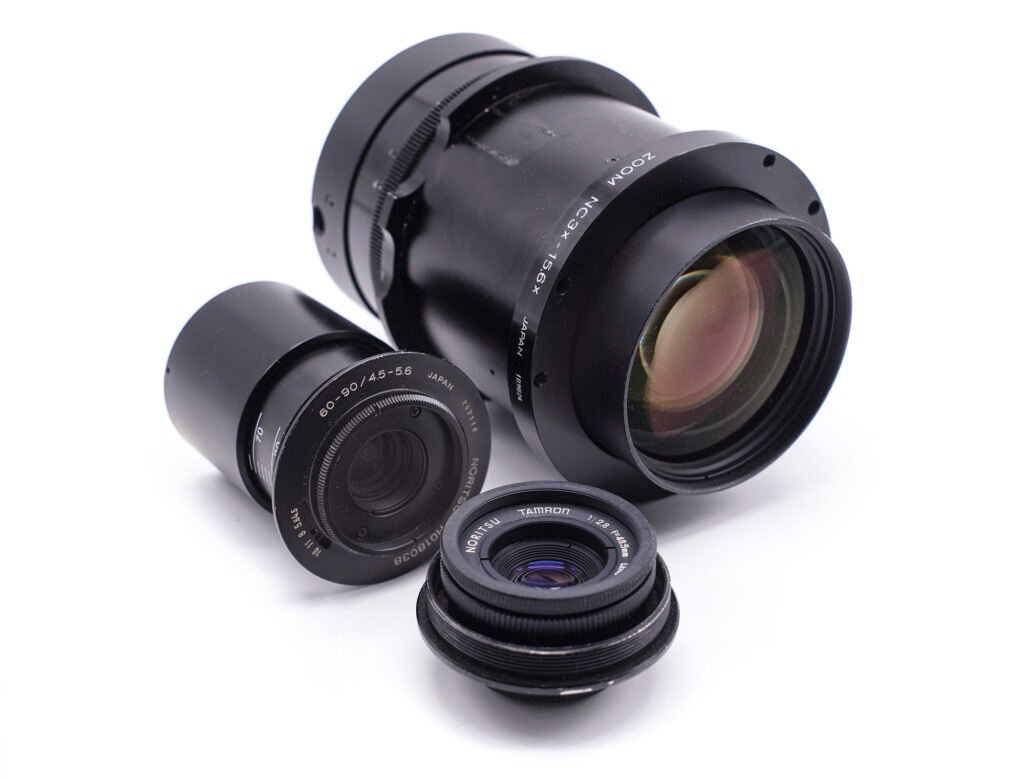
Zoom 5.3x – 17x
We have to assume that this lens can’t really be recommended for adaption – see above!
Nikon EL-Zoom-Nikkor for Noritsu 99-230/8

Even if you’re a hardcore Nikon fan who knows the whole history of the brand and the vast catalogue of Nikkor lenses, you would be excused if you’ve never heard of this one. The “Nikon EL-Zoom-Nikkor for Noritsu 99-230mm 1:8” (yes, that’s really the name engraved on it) is such a specialized, rare and also heavy and massive lens, that it just doesn’t seem to fit in anywhere in Nikons usual productions.
So it’s actually not easy finding a lot of information on this lens. Enrico Savazzi, a pioneer in terms of adapting and documenting very unusual lenses has written about this lens in his highly recommended and fascinating article on enlarging lenses already quite some years ago, even if he noted that he was “unable to test this lens because of its unusual characteristics.”
So in 2021 a fellow experimenter named Joel Rogers started to document his efforts in properly adapting this beast of a lens. If you want to read up on his findings, you can do that in his thread on photomacrography. When I reached out to Joel he was kind enough to provide some images as well as a short summary of his thoughts on this unusual lens:
“I initially purchased the lens because how often does someone run across a name brand lens that quite literally doesn’t exist. I wanted to document it, and ultimately if it was anything like the EL Nikkor’s of the same period use it for digitizing large format media. Being the first one to actually take a photo through it turned into quite the ordeal. Mounting a lens that heavy is significantly harder than what I realized. There is no copy stand or tripod on the market capable of supporting it in the vertical orientation. Add to that the unreal working distances with trying to find its parfocal length, one solution after another would quickly turn obsolete. But im glad I struggled through it, because at the end of the day it is an incredible lens that is in a class of its own.”

Weight: 82.5 lbs (37.4 kg).
Image by Joel Rogers.


Right: 19.5 mm/0.75 inch coin at maximum zoom (roughly 230 mm focal length)
Images by Joel Rogers.
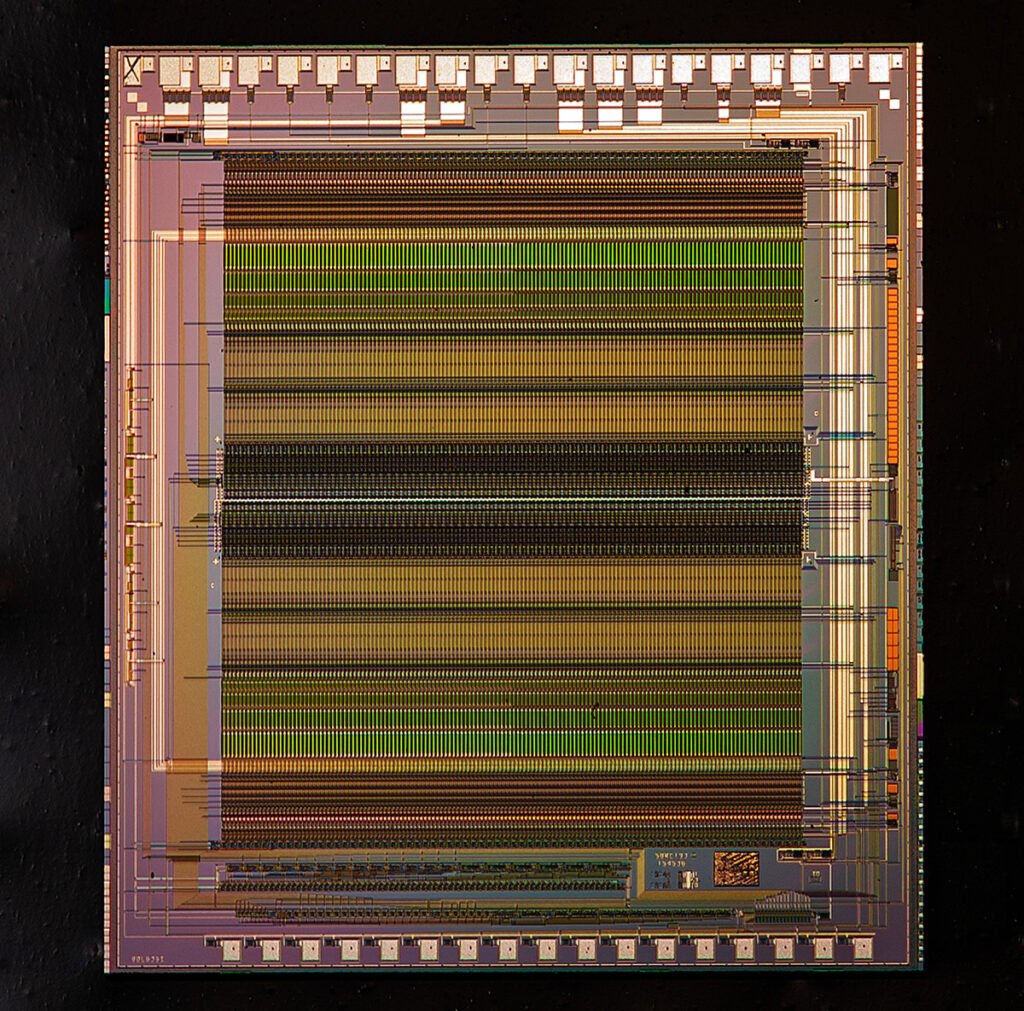
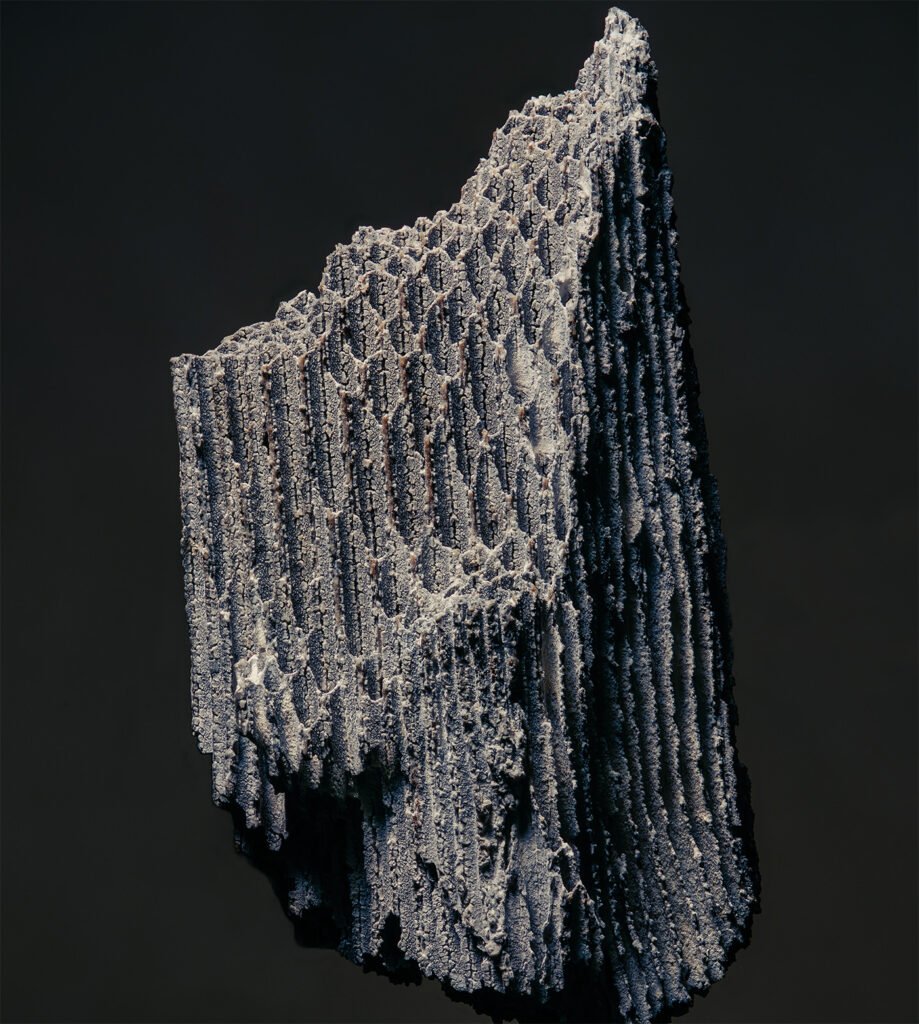
Right: What the inside of a catalytic converter is composed of.
Images by Joel Rogers.
Greetings from Japan
While we haven’t gotten any meaningful answers from Nikon regarding their involvement into the production of Noritsu lenses apart from the El-Zoom Nikkor, we got friendly greetings from Michio Akiyama, famous expert and collector of rare and unusual Nikkor lenses, who has created a really interesting and unique portfolio showing his lenses and findings on the site RED BOOK NIKKOR, which I recommend visiting if you want to learn something about a couple of Nikon lenses you might not have heard about yet.
Michio Akiyama was also kind enough to send us two images showing his sample of the El-Zoom Nikkor, one of which in a beautiful environment it’s probably not seen everyday. Arigatō!


So… should I get one?
As far as the varifocal lenses go, the short answer is: No! And the long answer? Still, no – unless you’re able to have fun adapting lenses, which a.) require you to think outside of the box in terms of mounting, focusing, stopping down etc. and b.) might come with some limits in terms of speed and quality at distance, compared to other vintage zoom lenses. But if those things don’t pose a significant obstacle in your mind and you’re curious about highly capable varifocal macro-lenses, which probably rival even some of the primes in terms of sharpness and beautiful rendering, they absolutely are worth adapting in my humble opinion. Particularly, if you find them for 10 dollars or less (as recently seen, in 2022). My personal recommendations are the common and often quite cheap 38-60 mm (particularly the N-version) and 60-90 mm, as well as the 26-49 mm and 71-111 mm variants, if you’re able to find one of those.
The fixed focal length lenses are very good as well, but I don’t think they’re on the same level as the significantly more common and better known 6-element high-end enlarging lenses (like a Schneider S-Componon, Rodenstock Apo-Rodagon, Minolta CE Rokkor or Fuji Fujinon-EX for example), with the exception of the 32 mm variant. This one I can absolutely recommend to any macro enthusiast, looking for a high-quality lightweight lens in that focal length to incorporate into a macro (stacked-lens) setup. The interesting thing the 45 and 48.5 mm lenses have, is an unusual aperture though (different star-shapes, which is uncommon among enlarging lenses) and opens possibilities for very unique bokeh experiments.
In my opinion it’s best to stay far away from most of the zoom lenses. They are heavy and cumbersome to adapt, not very flexible and also not convincing in terms of image quality. Same goes for all the 2-up, 4-up lenses etc. – they really seem to be of little value outside of their original purpose.
The El-Zoom Nikkor is certainly a more interesting lens, but unless you’re an extremely curious soul with lots of space, time and equipment to manufacture your own stand, as well as mounting solution, and you’re also getting a real bargain on the lens (which can be quite pricey), it’s also not recommended.
Thanks and outlook
I want to thank:
- Robert OToole from closeuphotography.com for sharing his knowledge and experience with Noritsu lenses, as well as his extensive and meticulous tests.
- Joel Rogers and Martin for sharing a lot of information and images.
- the kind people at Tamron, for trying to answer my questions on a lens, more than 40 years old and being genuinely curious to find out some details.
- Thomas Mümken and the team at Mümken Sales – the official german Noritsu partner – as well as some kind Noritsu employees in Japan who helped them find some official documents.
- (and last but not least) the incredible engineers at Nikon, Tamron, Tomioka, Zeiss (or some other company) who created these lenses: They are pretty spectacular, at least in my opinion. Thank you for your hard work!
Unfortunately I didn’t get any direct response from Noritsu Precision headquarters, who might be the most likely to still have some documentation on these lenses. If you have any way of reaching out to them more effectively, please let me know – I’d like to have them on board in order to provide more facts and fewer assumptions. Nikon didn’t show any real interest in looking into the extent of their involvement beyond the El-Zoom-Nikkor, when contacted, and so some of the open questions are probably destined to remain unanswered for now.
You call this an article?
I’m aware of course, that this write-up still contains a lot of missing pieces and much speculation. I’m also pretty sure that some more Noritsu lenses (probably both varifocal, as well as fixed focal length) might appear in the future. In order to give a more complete picture, I will certainly try to update this article accordingly. If you can provide any new informations, material like spec sheets, samples of lenses or corrections, please don’t hesitate to get in contact – I’d really appreciate any help!
One last word
In case you like some of the sample images provided above, perhaps consider taking a look at my flickr-page (flickr.com/photos/simple_joy) where I show quite a bit of my photographic experiments with a vast amount of unusual manual focus lenses. So, if you’re also on that aging, but still trucking-along platform for some reason, get in contact there or add a comment here. I would love hearing from you!








Hi Johannes,
nice lenses do you have discovered. I never discovered them on any selling platform.
Best regards
Bernhard
Thanks a lot Bernhard – glad you think so! They are not uncommon and can be found for very reasonable prices from time to time, however some are not easy to adapt and quality varies as outlined in the article. A couple of them are among my favorite industrial lenses though.
Nice to read. I have an Noritsu 112-145 H 018044 s/n 62959 with a perfect fitting NIKON 42 mm lenscover from an Noritsu 1501 minilab and some other lenses from the 1501 as well.
Thanks a lot! Great that you have that lens as well – have you tried it yet? Is there any other lens we’re missing from the 1501 roster?